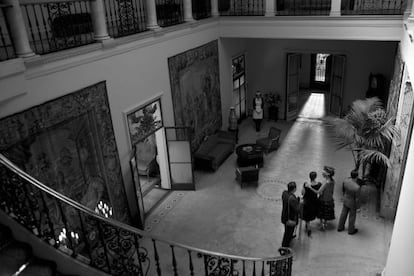A priceless collection left to Barcelona goes up in sfumato
The city was bequeathed the legacy of Julio Muñoz Ramonet, whose will made no mention of his daughters But most of the masterpieces are missing


This family story is unlike any other. It is the tale of an amazing art collection of incalculable value owned by an industry tycoon from Barcelona with a shady past who thrived under the Franco regime. It is also the story of four daughters who were disowned from this phenomenal treasure, which the father gave to the city of Barcelona instead. And it is the chronicle of the ensuing lawsuits between the city and the millionaire's heirs two decades ago, chapters of which have yet to be written. The last installment took place inside the elegant palace that Julio Muñoz Ramonet built himself at 288, Muntaner street.
A self-made man who built his fortune on the black market for cotton and by doing favors for the regime, Muñoz Ramonet died in 1991. That was when city officials were finally able to get their hands on a long-desired collection. This desire was legitimate, according to a Supreme Court ruling dated March 2012, which accepted the validity of the entrepreneur's last will, written in German in 1988. The document never once mentioned his daughters; instead, Muñoz Ramonet bequeathed the building and everything in it to Barcelona.
But what city councilor Jaume Ciurana found behind the intimidating gates of the palace, and after crossing the 3,000 square meter garden nestled in the heart of the city, turned out to be far less than what he was expecting. The real jewels in the crown of Muñoz Ramonet's art collection — including Goyas, Rembrandts, Grecos and Murillos — were not inside the legendary palace, which recently served as a set for the movie Blancanieves. The empty walls still showed the different shades cast by the masterpieces that had once hung there. In other cases, the gaps had been crudely covered with other works of little value.
"We want all the artworks that were there inside the house at the time of the death of Julio Muñoz Ramonet," says Ciurana forcefully. "We will not be satisfied with compensation."
Even if the city were willing to accept money, it would be practically impossible to set an amount. Muñoz Ramonet's is one of Spain's top private art collections, but there are no reliable estimates about the market value of the works that comprise it (supposing the market was capable of absorbing so much priceless art). In any case, the figures would be in the tens of millions of euros.

The genesis for this treasure trove of art lies in the collection of Rómulo Bosch Catarineu, which Muñoz Ramonet acquired in 1950 as part of his purchase of Bosch's cotton company, Unión Internacional Algodonera. The entrepreneur had just obtained over two thousands works including paintings, sculptures, archeological artifacts and porcelain vases from China and Sévres. The artists represented in Muñoz Ramonet's collection included Fortuny (with 26 works), Goya (18) El Greco (12), Sorolla (seven), Rembrandt (four), Murillo (three) and Zurbarán (another three). Velázquez, Botticelli, Monet, Berruguete, Corot, Delacroix, Renoir, Ribalta, Tiepolo, Titian, Zuloaga and others were also there.
So what remained of this eye-popping collection inside the Muntaner palace? Ciurana cites security reasons for failing to confirm what other city hall sources assure: that practically none of the masterpieces by the above-mentioned artists remain in Barcelona. "There are some pieces by Catalan and Spanish painters. The building is under private surveillance because starting on [August] 25 it becomes our responsibility," explains Ciurana, who said they need more time to draw up a complete inventory of the palace's contents, which also includes furniture, silverware, bed linen, curtains, rugs and more. This list will then be compared with the one that was drawn up during the protracted legal battle between the city and Muñoz Ramonet's children. "It will be a slow process. We don't want to speculate without all the data on hand."
This inventory will be the next stage of a journey that began in 1991 in Switzerland, where Muñoz Ramonet died as a man wanted by the Spanish justice system. He fled the country in 1986 to avoid facing charges of fraud and document forgery that could have landed him in jail for 11 years. He was 79 at the time of his death. His daughters concealed the unfavorable will until a story published in EL PAÍS in May 1995 alerted the city of Barcelona about a fabulous gift that it knew nothing about.
His rightful heirs later challenged the testament, alleging that it was not valid because it was written in German, a language that their father did not know well, and noting that Muñoz Ramonet had rewritten his will up to 11 times. From the beginning, his daughters — this newspaper was only able to contact one of them to ask for her version of events, but she declined to comment — have always claimed that the palace and the art within did not really belong to their father but to Culturarte, S. A., one of the entrepreneur's 30-odd companies. The daughters were shareholders in this firm after a capital expansion carried out three months before Muñoz Ramonet's death. This is why they claim that they did not need to inherit something that was rightfully theirs - a fortune of over 120 million euros by 1991 estimates.
Three rulings handed down by as many courts over two decades have dismissed these arguments. In the meantime, the daughters transferred the precious artworks to an undisclosed location, most likely in Madrid. The different inventories used by the various courts evidence the gradual depletion of artworks inside the palace.
“God rules above; the Muñoz here on earth”

When Julio Muñoz Ramonet fled from the Spanish justice system in 1986, he took refuge in a hotel in the Swiss city of Bad-Ragaz, in the same mountains where the popular cartoon character Heidi and her friends lived.
He arrived at this five-star exile after being accused of leaving a hole worth four billion pesetas (24 million euros) in the accounts of the insurance company Compañía Internacional de Seguros. In March 1991, High Court Judge Baltasar Garzón asked for a 11-year prison term for fraud and document forgery. Two months after that the embattled tycoon died. His body was repatriated and a wake held at the Muntaner palace where he had held so many glorious social events. It was the place where he kept one of his most prized assets, his art collection.
"God rules the heavens, and the Muñoz rule here on Earth," was a common comment about Julio and his brother Álvaro, two powerful men in a grey Barcelona, where a lack of scruples and good contacts with the Franco regime could get one far in life.
A man of humble origins, he amassed a fortune on the black market for cotton and real estate speculation. At the height of his power, he controlled 30 companies with more than 45,000 employees. This power grew exponentially in 1946 when he married Carmen Villalonga, daughter of the president of Banco Central. They had four children: Helena, Carmen, Isabel and Alejandra.
Julio and his brother owned the department stores El Siglo and El Águila, as well as Palau Robert, the Hotel Ritz and the small palace on Muntaner street, which they bought in 1945. His business dealings in Japan, Thailand, the Philippines and the Dominican Republic opened the doors of the private palaces of dictators like Ferdinand Marcos or Leónidas Trujillo.
In Switzerland — where he owned two banks, Spar und Kredit and Genevoise de Commerce et Crédit — he was known as "The Charming Spaniard" because of his great powers of conviction, despite his woeful French; he was also famous for riding in the back of his four Rolls Royces, which were driven by Federico, whom it was rumored had been chauffeur to King Alfonso XIII himself.
Those who knew him remember him as a man without too much knowledge about art, who used his collection to impress his guests just as he impressed them with silverware made not of silver but of gold. He bought the collection in 1950 from Rómulo Bosch Catarineu, who had used it as guarantee for a loan meant to refloat his cotton company, Unión Industrial Algodonera. He lost both to Muñoz Ramonet.
Some sources claim that Julio Muñoz Ramonet never got over the fact of not fathering a son. This might explain the indifference and even contempt he showed toward his daughters throughout his entire life. After his death on May 9, 1991, the women concealed their father's last wishes — that the city of Barcelona should have his assets.
But his daughters always felt that both the palace and its contents were never his property to begin with, but that of Culturarte, S. A., a family company that they hold shares in after a capital expansion conducted three months before Muñoz Ramonet's death. That is why they feel that they are not so much the rightful heirs to the collection, as the rightful owners.
A 1968 document talked about 500 paintings, 50 altarpieces and five large tapestries; by 1998, this figure had been reduced to under 300 works. The latest list, drafted in 2005, shows a similar amount of works, minus all the major masterpieces. Sitting in their place are figurative paintings and landscapes acquired by the entrepreneur from artists in the 1970s and 1980s. As an exception, there is one Velázquez and one Rembrandt left.
There is ample evidence that the collection has been plundered over the course of the years. Some are obvious to anyone who went to see the successful film Blancanieves: the walls of the palace, which is meant to be the evil stepmother's house, are nearly empty. Other, more subtle indications include a 1960s document that this newspaper has had access to, describing the entrance hall as containing 46 paintings, five altarpieces and three tapestries by the likes of Boticelli, Goya, Rembrandt, Monet, Murillo, Titian, Ribera, Fragonard, Madrazo, Zurbarán, Veronese, Renoir, Grünewald and Tiepolo. The room next door was said to hold 24 more oil paintings by Murillo, Rafael, El Greco, Rigaud, Mengs and Velázquez. Yet the 2005 inventory only mentioned seven paintings as being in these same rooms.
A 2007 ruling by the Provincial Court of Barcelona certified that it was common practice at the palace to spirit artworks away. According to Judge Maria Sanahuja, Culturarte took out several insurance policies in October 1991 (after Muñoz Ramonet's death). One such policy, worth 1.8 million euros, covered the transfer of 325 works to a palace on Madrid's Villanueva street, a property of the family. The following month, according to this same judge, the daughters took out another policy worth 21 million euros to insure the work inside the Madrid palace. This ruling established that Muñoz Ramonet's legacy should be based on the 1968 inventories, and this view has recently been confirmed by the Supreme Court.
Another document that EL PAÍS has seen shows that in February 1992, a US art expert named Lori Gross was paid 300,000 pesetas (1,800 euros) to provide advice about which works should be selected for transfer from Barcelona to Madrid; this expert also supervised the unpacking of the paintings.
But at least two of the most valuable artworks have been located. Since 2011 they have been in the custody of a courthouse in Alcobendas (Madrid), and they are being claimed by the Julio Muñoz Ramonet Foundation, created in 1995 to defend the interests of the city of Barcelona.
The paintings in question are The Annunciation, by El Greco, and The appearance of Our Lady of the Pilar, by Francisco de Goya, whose collective value has been assessed at seven million euros. They were recovered by the Civil Guard in Alicante just as they were about to be sold, and the operation constitutes another twist in the tale: police were alerted by one of the deceased collector's daughters, who accused her ex-husband of stealing them from their home in 2000. According to Ignasi Domènech, a museum expert, both paintings are very important. "Especially El Greco's The Annunciation. Another version hangs at the Prado, but Muñoz Ramonet's is much bigger and better."
When identification work on the missing pieces ends, the city of Barcelona will have to file the corresponding claims. Everything suggests that the artworks will end up at the National Art Museum of Catalonia (MNAC), whose trustees include city representatives. But Ciurana does not rule out sending part of the legacy elsewhere. Meanwhile, the palace could end up as a local library, but Ciurana is cautious: "We will have to respect Muñoz Ramonet's last wishes."
Tu suscripción se está usando en otro dispositivo
¿Quieres añadir otro usuario a tu suscripción?
Si continúas leyendo en este dispositivo, no se podrá leer en el otro.
FlechaTu suscripción se está usando en otro dispositivo y solo puedes acceder a EL PAÍS desde un dispositivo a la vez.
Si quieres compartir tu cuenta, cambia tu suscripción a la modalidad Premium, así podrás añadir otro usuario. Cada uno accederá con su propia cuenta de email, lo que os permitirá personalizar vuestra experiencia en EL PAÍS.
¿Tienes una suscripción de empresa? Accede aquí para contratar más cuentas.
En el caso de no saber quién está usando tu cuenta, te recomendamos cambiar tu contraseña aquí.
Si decides continuar compartiendo tu cuenta, este mensaje se mostrará en tu dispositivo y en el de la otra persona que está usando tu cuenta de forma indefinida, afectando a tu experiencia de lectura. Puedes consultar aquí los términos y condiciones de la suscripción digital.
Últimas noticias
Reinhard Genzel, Nobel laureate in physics: ‘One-minute videos will never give you the truth’
Pinochet’s victims grapple with José Antonio Kast’s rise in Chile
How Japan is trying to avert ‘digital defeat’
The complicated life of Francesca Albanese: A rising figure in Italy but barred from every bank by Trump’s sanctions
Most viewed
- Pablo Escobar’s hippos: A serious environmental problem, 40 years on
- Why we lost the habit of sleeping in two segments and how that changed our sense of time
- Charles Dubouloz, mountaineering star, retires at 36 with a farewell tour inspired by Walter Bonatti
- Trump’s obsession with putting his name on everything is unprecedented in the United States
- The Florida Keys tourist paradise is besieged by immigration agents: ‘We’ve never seen anything like this’








































